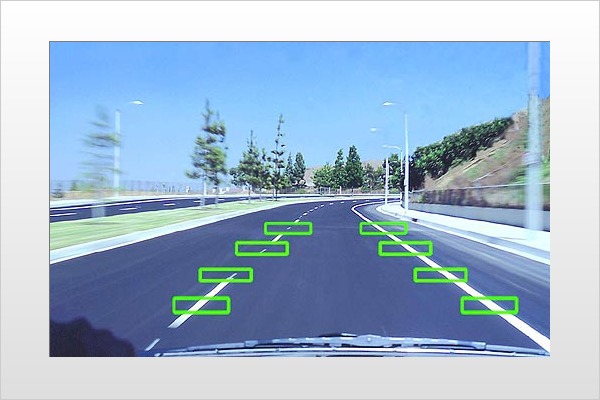
In suburban Los Angeles, a motorist was driving through a residential area when he dropped his cell phone on the floor of his car. Reaching for the phone, he momentarily took his eyes off the road — and struck and killed a jogger who was running on the shoulder.
Accidents like this, and many others, might soon be averted by a device that uses an emerging new technology created by the Anaheim, California-based company Iteris, Inc. A small camera mounted behind the rearview mirror watches the lane markings as the car moves forward. If the car begins to wander out of its lane, without a turn signal being activated, a warning buzzer is sounded.
According to the National Highway Transportation Safety Administration (NHTSA), there are almost 1.4 million road departure crashes reported annually. Preliminary NHTSA research suggests that lane departure technology, like AutoVue's and those found on other OEM applications, may be 32 percent effective in preventing road departure crashes.
Engineers have found the "rumble strip" an effective warning for drivers who stray off highways. Iteris' device, called AutoVue, Lane Departure Warning (LDW) system has effectively created a virtual rumble strip along all roads that have lane markings. The system will prevent drivers from falling asleep at the wheel and driving off the road. But it will also serve as a wake-up call to inattentive drivers.
What the AutoVue system does sounds simple enough. But the software that drives the device has to be incredibly sophisticated, able to distinguish different types and colors of lane markings in different lighting and weather conditions.
In the early stages of development, "a van full of equipment" was needed to run the system, said Francis Memole, AutoVue vice president of marketing and business development. Mercedes-Benz came to the company and said, "Could you take this and make it small and affordable so we can put it in cars?" After three years of research and development, the first systems were installed in vehicles in Europe where they have now logged some six million miles of use.
The unit's camera tracks lane markings and feeds the information into the computer, which is also monitoring the vehicle's speed. Using image recognition software and proprietary algorithms, the computer detects when a vehicle drifts into an unintended lane change and triggers a warning, alerting the driver to make a correction.
AutoVue is already being offered as a factory-installed option on Freightliner's Century and Argosy trucks. Automakers offering a Lane Departure Warning System on some of their models include Audi, Infiniti, BMW, Cadillac, Volvo and Buick.
At a recent event, Iteris provided several cars equipped with the AutoVue system for test-drives. When the driver got within about a foot of the left- or right-lane marking, a buzzer sounded. Memole explained that several warnings could be programmed into the system. As a joke, a company technician used Homer Simpson's voice with his trademark exclamation: "D'oh!" A vibrating device under the driver seat can also be used. The system does not sound an alarm at speeds under 37 mph, because it was first developed for European cars — 37 mph converts to 60 kilometers per hour, an even number selected as the cut-off point.
Bill Patriolia, director of North American Truck Sales, said he has collected statistics and information about truck accidents. The rumble strip, a physical counterpart to the AutoVue system, has been incredibly effective in preventing fatal accidents on high-risk sections of rural highways. The AutoVue system works on a similar principle, serving as a constant reminder to truck drivers to stay in their lanes.
One trucking company Patriolia spoke with, which had a fleet of 300 trucks, suffered five serious accidents in one year. Three of those five accidents were due to unintentional lane departures and could have been averted using AutoVue.
The same technology that drives the LDW system could be used for several related applications. One use would be to sense an approaching tunnel and turn on the headlights before the driver finds himself in darkness. Another use would be to detect rain on the windshield and turn on the wipers and control their speed. A blind spot warning system has already been developed by Iteris that monitors the lanes adjacent to the vehicle. If the driver signals his intention to change lanes, and a car is in the blind spot, an audible warning is generated. A version of this blind spot detection technology is now available on certain models from Audi, Chrysler, Chevrolet, Dodge, Jaguar, GMC, Mercedes-Benz, Mazda, Volvo, Cadillac, and Buick. According to a 2008 study conducted by the Insurance Institute for Highway Safety, blind spot warning/detection systems have the potential to prevent up to 457,000 crashes annually.
After a short time driving in a car with the AutoVue system, it was easy to forget the device was even there. However, as soon as the driver makes a lane change without first signaling, the buzzer comes alive. This shows that even if you forget it's there, it doesn't forget to do its job. It's always watching the road, even when you aren't.
Related Articles:
New Warning Systems Save Drivers From Themselves
Top 10 High-Tech Car Safety Technologies